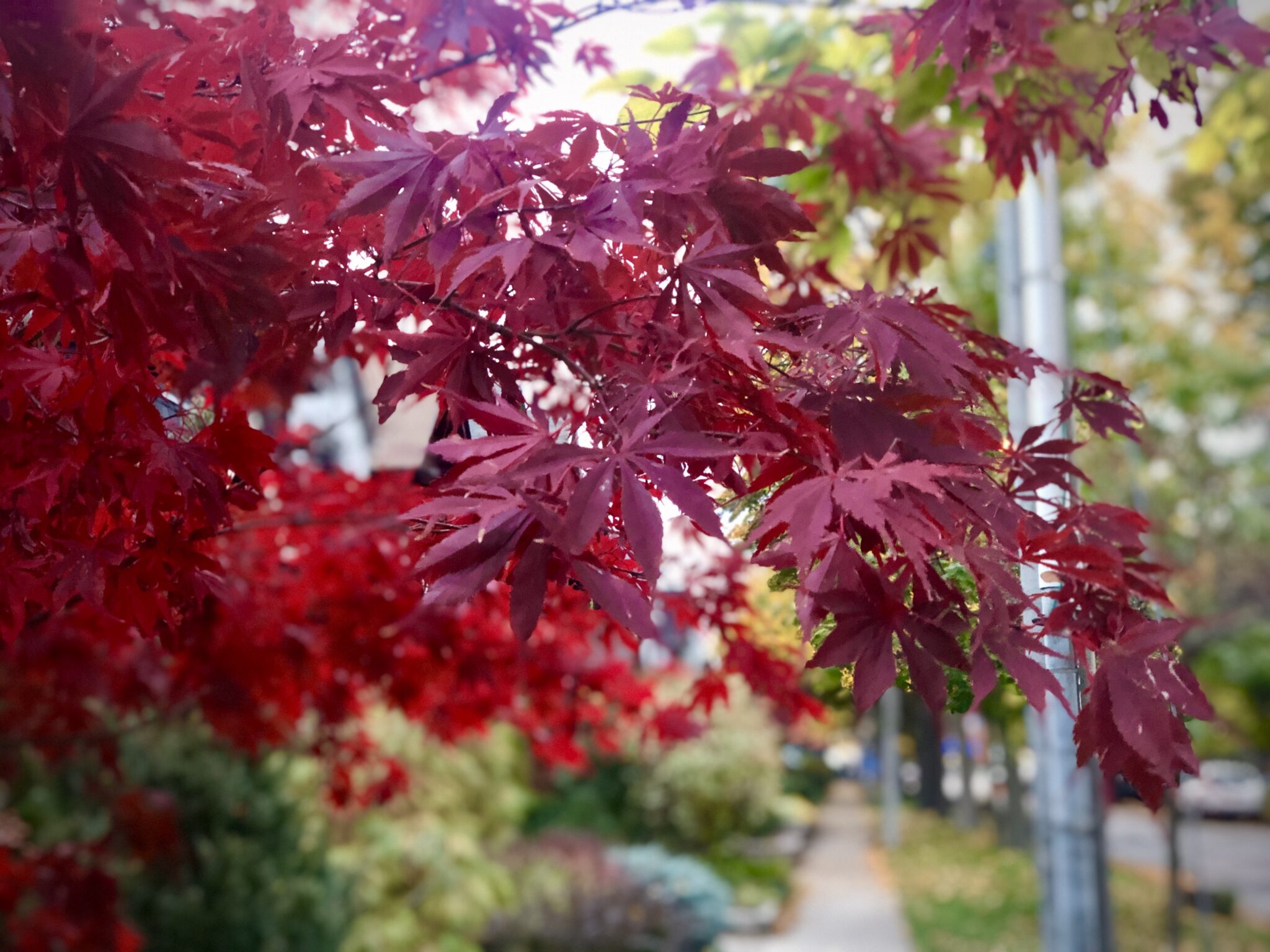Posts Tagged ‘memories’
Keeping Records
By Alyssa Warmland
I pulled the photos out of their envelope one at a time, turning over each one to carefully record the date, place, and people in the photo. Sometimes, I included comments. “Apple picking in Hamilton with Pop Pop, Fall, 2023. You loved the wagon ride!”. I slipped each picture into an empty pocket in my son’s photo album.
Next, I pulled out the baby book I’ve kept since before he was even earthside. I flipped to a page at the back to record an appointment, a new adventure with a forest homeschool group, and milestones.
When I tell other people my age about these rituals, they tend to share that they wish they were better about printing pictures and writing in their kids’ baby books. I’ve always enjoyed documentation, an avid journalkeeper as long as I’ve been able to write. I’ve considered this another extension of that interest. It wasn’t until earlier this week that it hit me- I keep these records so that if I die while my kid is young, he will have access to this information.
When I was 14, my mom was diagnosed with terminal cancer. I remember the day my dad picked me up from school and told me the results of the biopsy. I remember riding beside him in the passenger seat and thinking, “She’ll never meet my kids. She won’t be at my wedding. She won’t see me graduate.” All the milestones we would spend apart ran through my head. In the years since her death, I’ve consulted my baby book and read, over and over, the notes she wrote to me.
When my son was born and I became a mother, I read the notes in my book. When he started getting teeth, I turned to my (and my brother’s) books to find out when we got our teeth. I’ve looked up when we potty trained, what our sleep was like, about her breastfeeding experiences, when we started going to the dentist, and, most recently, upon learning that I was expecting another baby, what it was like when my mom brought my brother home. Not all, but some, of my questions I wish I could ask her about were answered in this record she lovingly kept.
As I write in my son’s books and caption the photos I’ve printed, I honour her, my child, and my own mother/child self. I hold space for my grief and for her memory. I continue a tradition of mothers keeping records to pick up when our babies need them.
There One Day and Gone the Next : Art Therapy and Grief
By Sarah Smith DTATI, BFA
Over the last 12 years or so, I’ve had the opportunity to work with those grieving individually and in group settings, which has provided me with experience and insight into how art therapy (and art as therapy) can be beneficial to those dealing with loss.
What is Art Therapy?
“Art therapy combines the creative process and psychotherapy, facilitating self-exploration and understanding. Using imagery, colour and shape as part of this creative therapeutic process, thoughts and feelings can be expressed that would otherwise be difficult to articulate,”(CATA, 2022).
There’s no right or wrong in art therapy, it’s a matter of using the art as a vessel for wellness along side a trained professional. There are many benefits one can receive from engaging in the art making process such as: healthy coping strategies, insight, emotional stability/balance, stress /anxiety reduction, grounding of emotions, pleasure/joy, creativity, safe space, expression, control, freedom, and connection among many others!
Art Therapy and Grief
Grief is a very layered and challenging thing that is unique for each individual who experiences loss.
Because there is no “proper” way to grieve, art therapy can make for an excellent coping strategy as it allows for each person to express themselves in the way that’s best for them.
Unlike traditional “talk therapy”, art therapy has the art, so this means that one does not need to speak if they don’t want to or if they cant find the way to articulate how they feel into words. Sometimes, while people are grieving they cant even pin point how they feel and at other times the emotions can just be so overwhelming it can affect one physically and to try and talk about the emotions just exacerbates them.
Creating art in itself can be a healing thing. It can be a fun or relaxing thing to do. Engaging in an art therapy session can allow for so many more benefits. The art therapist can provide the participant with specific art therapy directives and art materials that they feel may be beneficial to your needs. Art therapists are trained to read and assess clients’ artwork. This means they may see things you may have missed that you might benefit from if brought to your attention. This insight makes it a great learning tool for self-discovery. We as art therapists believe that the art work holds the subconscious. What’s great about this for those who are grieving is that people can process however they need to. Some people need more time to process, some people need a more gentle approach where they feel in control, some people refuse to acknowledge things, and some people are just going through the motions and engaging in the art making process. The subconscious is purging and the healing is happening whether they realize it or not.
Art Therapy Directives (examples)
I facilitated a workshop at a hospice a couple years ago and offered it to those who had lost a loved one. The workshop began with a few art therapy warm-up exercises with the intention of helping everyone feel a bit more comfortable in the space and with each other.
The first art therapy directive I had them do was make flowers out of coffee filters, markers, and water. I wanted them to make something symbolic for their loved one. They began by writing whatever they wanted onto the coffee filters. Some people wrote the persons name, poems, a memory, or even drew a picture. They then watered down the filters and the colours began to bleed. Some people cried during this part. They could resonate with the symbolism. The water like tears. The bleeding of the colours representing pain, fuzzy memories, and a distant grasp on the person. When the coffee filters had dried we had turned them into flowers. The transformation of taking what we lost and carrying it forward in a new way was very powerful to witness and a very healing thing to say the least.
The second art therapy directive was focused more on the individual rather than the deceased. I gave everyone a mask. I instructed them to paint the front of the mask how they appear to the world and I asked them to create on the inside of the mask to show how they really feel or how they are actually doing (see figure 1).
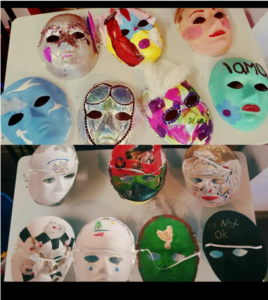
Figure 1.
They shared their art work from the workshop, but it was heavy. They were feeling sensitive and tired among other feelings so I had them sit and talk for a bit and then had them pull a self-care card for a distraction before letting them and drive home, as it may not have otherwise been safe for anyone overwhelmed after such an engaging session. This is typically how I run a grief workshop. Before they left the hospice asked them to fill out a score sheet to see how they felt about participating in the workshop and everyone said they liked it and for reasons, such as that they felt less anxious, they felt less alone, the felt lighter and more hopeful after the workshop.
At another hospice art therapy workshop, I had them create memory boxes. I provided them with a wooden box along with a variety of art materials, the only thing I asked was that they brought in a picture of the person they had lost. The purpose of this was to give them an opportunity to create something that could hold two energies, a place to honour them deceased, but also something tangible for them to have and hold. From my observations, I remember them taking a lot of time on these boxes and they were very quiet while making them. When they shared them, they were emotional, of course, but pride came through, it was like they made them for their people and wanted to make them well, so that their loved one would really like the box. This made them feel good for reasons such as honouring the person still while they are gone. Some people felt that their guilt had been eased a bit because they were physically doing something for that person who was no longer here. To see an example, see figure 2 and 2b.
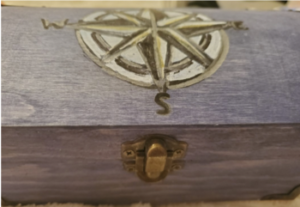
Figure 2
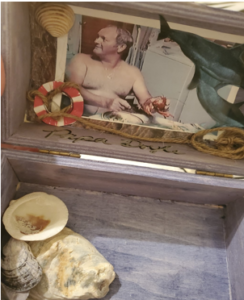
Figure 2b.
Following the memory boxes, I had them paint a step by step painting for their loved one. This was more of an art as therapy approach. This means they were literally using the art itself for wellness. They followed along with me and painted a whole painting. By following me, they were able to safely let go and get lost in the art making process. The intention was to enjoy the process while also giving them a healthy mental and emotional escape for however long it took us to paint the picture. I selected a picture of trees that had no leaves, purposely to symbolize letting go, loss, and reflection but the painting had an element of hope to it, the tress were pointing up to the sky, facing the light and there was lots of colour (see figure 3).
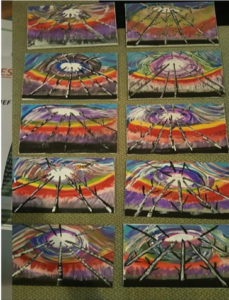
Figure 3.
The photos below are some examples of art from some of my sessions with clients around grief. They speak for themselves.
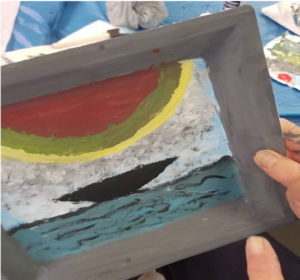
Figure 4.
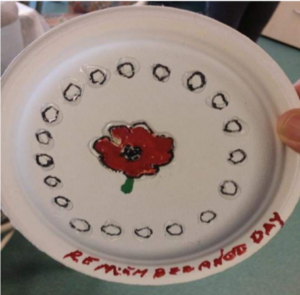
Figure 5.
Grief and Disability: Carrie’s Story
By Carrie Batt, Grief Educator
My son says I am a mover and a shaker. He tells his friends that because of my extensive travels abroad and my volunteering. When his friends ask: “Why did she do that?” he always tells them “Because my mom believes that ‘anything is possible’.” As I look back on my journey, I know where I picked up this motto. When my baby brother was born, the doctors told my parents: “he will not walk, talk, nor know who you are”. From that day on my parents embodied that motto ‘anything is possible’ and in the end my brother does far more than walk and talk. This circumstance introduced me to the disability community knowing that people with disabilities deserve and can do more. Interestingly, I have had the privilege of working within the developmental sector in a variety of positions for more than thirty years.
In 2018, I added to my parents’ motto ‘anything is possible’ and included ‘everyone is worth it’. I added those words to the motto right after I had attended a kintsugi workshop offered by Rami Shami, a prominent member within the deathcare community. As soon as I realized that Rami had spent the last 30 years caring for the dying. I inquired about his experience in death, dying and disability. Rami unfortunately, had no experience in supporting people with a disability who were dying. Upon learning about the sheer lack of support and expertise on this topic, I proceeded to complete the end-of-life training with Beyond Yonder Community Deathcare program. Soon after, SEOL Care was created, which offers a disability-sensitive approach to death, dying, and disability.
It has become clear to me over time that we have much work to do to ensure the delivery of disability-sensitive grief literacy and grief support. In March of 2022 my proposal for four 1-hour sessions was approved, we provided the program for 20 participants. My heart was full in each session.
My heart remains full of hope that conversations, education, and expertise about disability sensitive end of life care and grief support will gain momentum as more and more people join in on this vital conversation.
Currently, there are several rays of hope that suggest grief education and support can and will be offered in a more inclusive way. As a certified grief educator, I now offer online disability-sensitive grief support services for individuals and groups. My employer is offering disability-sensitive grief literacy sessions. The Bereavement Ontario Network has shared information through their newsletter and in a network webinar, where the gentleman I support and I were the guest speakers. Bereaved Families of Ontario have been receiving multiple requests to provide grief resources for the neurodivergent community. Additionally, Bereaved Families of Ontario are seeking out speakers with lived experience related to grief and under-represented communities for their grief literacy series. I remain grateful knowing that these are hopeful times, and these examples are a positive step in the right direction.
Jane – Remembering loved ones
Jane – Remembering loved ones
Jane talks about some ways she remembers her grandparents since her passing and the comfort that brings her as she grieves for them.
Madelyn – The power of music
Madelyn – The power of music
Madelyn – discusses the potency of music and processing good and bad memories
Practical Possibilities for Mourning in a Pandemic
Post by Maureen Pollard, MSW, RSW
Practical Possibilities for Mourning in a Pandemic
When someone we care about dies, we have a natural reaction of grief. During a pandemic, many restrictions and precautions we are living with to help prevent the spread of virus can interfere with the ways we are used to coping with the experience of grief. Here are some strategies that can help:
Hold a small, personal gathering and share it with live-streaming. You can use Facebook or Instagram Live to share your ceremony with people who might want to observe it since they can’t participate in person, thus ensuring that anyone who loved the person can honour their passing.
Hold an interactive virtual gathering to celebrate the person’s life. Just about everyone can Zoom these days, and in a virtual meeting you can join in and take turns telling stories about the person who died, or play music and remember together in a more personal and interactive way than by live-streaming a small ceremony.
Create a slideshow using photographs and music. You can tell the story of the person’s life using photos through the years and with music they loved, or you can make a tribute to the things that were important to them or about them in their last years of life.
Create a memory book either using a scrapbook, or an on-line photo-book service. Again, you can show their life over time, or create small personalized books that show their relationship with you, or with other special people in their life.
Dedicate a space in the house to the person who died. It could be a shelf or a corner table. Place their picture there, and maybe a candle or something that reminds you of them. Spend some time in this spot when you want to feel close to the person.
Dedicate a time each day to grieving. You may find that by setting aside particular times of the day or week to miss and mourn the person who died, your grief becomes less intrusive as you go about the tasks of your everyday life.
Bring out their favourites. Watching their favourite movie, playing their favourite songs and eating their favourite foods can bring back positive memories. Wearing their favourite robe or sweater can help them feel close.
Find your own favourites. Choose a movie, music or other sensory experience that reminds you of them in a way that you find soothing. Sometimes it can be too hard to revisit their favourites but it can be comforting to choose your own.
Make art in their memory. Paint or draw a picture. Write a poem or story. Write a song or choreograph a dance. Create a sculpture or needlework. Art helps us express powerful feelings in a wide variety of ways and can help us heal.
Take care of yourself. Be gentle and do the things that bring you comfort and ease. Maybe a long hike. A hot shower or bubble bath. Cuddling up on the couch with a cup of tea and a good book. By giving yourself calming, pleasant sensory experiences you give your heart time to heal.
The Unique Wounds of Ambiguous Loss
Post by Maureen Pollard, MSW, RSW
The Unique Wounds of Ambiguous Loss
Ambiguous loss, as it relates to death, happens in two ways.
A loved one may be physically absent, missing and potentially dead, but without definite evidence to confirm a death.
A loved one may be mentally absent due to conditions like dementia or other circumstances near the end of life that make them inaccessible to us even though they are physically still alive.
In either circumstance, family and friends are impacted by the absence of a formal acknowledgement of loss that begins an outward, expected grieving process. Instead, there may be an on-going dance between anticipatory grief, and the possibility of hope.
According to the work of William Worden, the tasks of mourning include a need to accept the reality of death. When you do not have the chance to view a still body, to touch a cheek one more time, and come together with others in a gathering to honour the deceased, it can be difficult to find a way forward. Similarly, when your loved one has good days and seems bright and well, it may be hard to accept the truth of a terminal diagnosis.
In either scenario, it’s common to seek information and it’s unusual to find definite answers. The ambiguity creates a storm of mixed emotions quite different than the experience of other death that is as clear and complete as it is heartbreaking. Denial is a common experience. It can be easier to avoid the facts when the situation is uncertain.
Denial can prevent families and friends from adapting to the situation. The unresolved situation of a missing person can leave people stuck, afraid to move on for fear of letting their loved one down. In the case of a family member becoming absent through such conditions as dementia, or decreasing consciousness, denial may mean that people miss the opportunity to be present, to appreciate the person who is dying and to say a meaningful goodbye. Either way, the wounds of ambiguous loss linger, difficult to heal as the mourner struggles with questions and regret.
Healing through ambiguous loss involves the ability to redefine a relationship with the person in their absence. Sometimes this involves adapting how you think about them and other times it involves actions you take to respond to the difference in how things are now. Once you have gathered as much information about the situation as possible, you can begin to make choices about how you will think and act in relationship to this difficult situation.
There is no one right way to adapt to ambiguous loss. Each person must gather relevant information about their own situation, and then set boundaries that help with adjustment. If you face such circumstances with someone in your life, be sure to hold yourself with deep compassion as you move through these steps and tend to your own needs. It will not always be this way. You can make meaning and find hope through your thoughts and actions in such a way that will allow you to rest as easy as possible even under such circumstances.
Guilt and Remorse in Grief Work
Guest post by Sharron Spencer, SSW-G, RSSW
Sharron Spencer is a Registered Social Service Worker working in the field of Mental Health & Addictions since 2014, as a second career. Sharron currently works as the Grief & Bereavement Coordinator at Hospice Georgina. She trained in the Child & Youth Grief and Bereavement Certificate program with Sick Kids Mental Health/Hincks Dellcrest, and is nearing completion of a degree in Thanatology (the study of death, dying and bereavement) with Western University. Sharron is a training facilitator with PalCare Network of York region; providing palliative education programs to volunteers and professionals in Spirituality, Grief & Bereavement and Care for the Caregiver and also a certified facilitator of Powerful Tools for Caregivers. Sharron is also a Certified Funeral Celebrant.
Most of us don’t think about our own mortality. Often, it isn’t until we are affected by a diagnosis or sudden death personally that we have to learn how to cope with the shock, fear, anger, sadness, guilt, numbness and many other emotions that result from a death, or dying. We have become a death-denying society that resists all things related to death and dying. Our loved ones are cared for in hospital and their bodies are cared for by the funeral homes. In many ways we don’t know what or how to grieve.
When diagnosed with a life threatening illness, one is often filled with guilt and regrets; their lifestyle, choices they made, becoming a burden to others who will need to help provide care, leaving a family without an income and many other thoughts cross their mind.
Children and youth may be left with guilt and remorse after the death of a parent or other family members. They may believe they caused their loved one to become ill because they didn’t ‘behave’ the way they were asked to, or they may feel terrible because they fought with the person, or they didn’t spend enough time with their loved one because they didn’t really believe they were gong to die. It’s important to explore these possible thoughts and feelings with children and youth, helping them understand the death in an honest, age-appropriate way. This can help prevent them from imagining worst-case scenarios where they are to blame.
A caregiver to a loved one with a disease such as dementia can be filled with guilt for being exhausted and feeling resentful towards their loved one due to the amount care and attention that is required. They may also feel guilt for grieving the loss of their hopes and plans that have been lost due to the illness.
Guilt and remorse can overwhelm us whether we are grieving the death of someone we love or facing the end of our own life. These feelings are normal and very common. The trick is to not let the guilt take over and stop you from grieving your losses.
When we must watch someone we care about as they suffer and decline, we may feel helpless. That powerlessness can turn into guilt that we weren’t able to “fix” things. Even when we understand logically that there was absolutely nothing that we could’ve done differently, our heart takes on this guilt. Professional help can help you find self-compassion and forgiveness.
It can also be therapeutic to write a letter to our loved one who has died. Write about your feelings, including the guilt and the remorse. I often suggest to people to burn or shred the letter to release the guilt, shame and remorse. These painful feelings don’t serve you and won’t change the outcome. You can let them go and trust that you did the very best you could for your loved one under the difficult circumstances you faced at the end of life.
When Death is a Natural Part of Your Workplace
Post by Maureen Pollard, MSW, RSW
When Death is a Natural Part of Your Workplace
Staff and volunteers in hospice, long-term care facilities and hospitals know that death is a part of life. You typically witness death on a regular basis as part of your job. As a result, there are some important steps you can take to engage in self care and look after yourself when loss and grief are a part of the emotional landscape in your workplace.
Consider your personal experience of loss.
Self awareness is helpful as we reflect on events in our life, our personality and our actions. Think about family and friends who have died. Reflect on your grief. How did you feel? What did you do to honour the loss? Was there something that helped you cope with your grief?
Honour your relationships.
When death is part of your work, you become good at dealing with the practical aspects. Loss of life may be business as usual, and your training, skill and experience allows you to do what is necessary and then move to the next tasks. As a result, it can be surprising when a death happens that touches you. Remember that grief is really about relationship. It’s natural to feel more attached to some patients because of a personal connection that develops as you care for them over time or because they remind you of someone you love. When you have some relationship with the person who died, you’re much more likely to need a bit of time to process your grief.
Be aware of the impact of accumulation.
It may be that very few of the workplace deaths you encounter feel personal. As a result, you become very good at moving through the tasks of caring for the dying and coping with death. This is a normal development as you gain experience in the field. However, it may come to pass that you feel the weight of the number of deaths you attend to over time. This is also a normal occurrence. It’s as if each death is a rock you place in the backpack you carry. On it’s own, one rock is not too heavy to carry. Eventually a backpack full of rocks becomes impossible to lift. It’s important to have healthy ways to express your feelings and release these “rocks” now and again throughout your career.
Feel it, then heal it.
When grief comes to you, whether it is in your personal life or due to deaths you experience in the course of your work, take the time you need to mourn. Each death will bring a range of unique feelings. Some will take a long time to mourn and others will be a small diversion on your path. When you honour each loss according to the depth of love reflected in the relationship with the person who died, and take time to heal, it increases your capacity to carry on in your work as an excellent professional caregiver.
Ways to Mourn During the Pandemic
Post by Maureen Pollard, MSW, RSW
Ways to Mourn During the Pandemic
The restrictions related to the global pandemic are intended to slow the spread of covid-19. Physical distancing, the declaration of a state of emergency and rules to prevent gathering in groups also impacts our usual ways of coming together in bereavement.
It is customary for immediate family and close friends to attend for final visits if the death is expected. After death, there are many rituals, ceremonies and customs that involve gathering together to remember, honour and celebrate the person who has died. When you can’t gather to comfort one another, there are still many ways you can mark the death of a loved one.
Use Technology
You can schedule on-line video sessions using FaceTime, Skype, Zoom or other platforms to host virtual gatherings at times when the bereaved would normally be offered condolences and comfort in person such as a visitation, a wake, shiva or other mourning traditions. Similarly, it is possible to use livestream technology to invite family and friends to observe any private ceremony or service that is allowed for the immediate family. This technology has been available through funeral officiants in the past, and during the pandemic it has become a much more familiar experience as such technology becomes the only safe way to attend and offer sympathy and support in the immediate aftermath of a death.
Create Personal Ceremony
While it is customary to come together for a public, shared mourning through traditional gatherings, it can be equally meaningful to create private ritual and ceremony to honour your relationship with the person who died. You may choose to light a candle, recite a prayer or poem, listen to music that feels sacred to you in connection with the relationship or create art to express your feelings. You may choose to share images with others through social media, by email or text. You might create an audio-visual presentation to share with other mourners that tells the story of your relationship with the person who died. These personal expressions of grief and love, shared in community, may help create the feeling of connection and comfort that is usually found in traditional in-person gatherings.
Plan For the Future
This is a difficult time, and no one can say how long the restrictions will last. At some time in the future, covid-19 will be managed by the scientific and medical communities and the rules of physical distancing will be eased. While you wait for that time to come, you may find some comfort in planning a more traditional gathering of family and friends to honour and celebrate the life of your loved one once the situation evolves and it is safe to gather once more.
Loss Comes In Layers
Post by Maureen Pollard, MSW, RSW
When we experience death, it is often perceived as one-dimensional. A person died. We are sad and we miss them. That is grief.
Grief is much more complex than this perspective suggests. When someone we love dies, there are multiple aspects to the loss that impact our grief journey.
Of course, we do miss the person who died. When we love someone and we know that they will be absent from the rest of our lives, it does make us sad. It also opens our broken hearts to myriad other feelings, depending on the relationship.
When someone in our life dies, we may also lose our status or role as created by that relationship. When our parents die, we become an orphan. When our spouse dies, we become a widow or widower. The death of a child is so powerful that there is no similar word to identify the new role a bereaved parent takes on. With or without a special term for the new status, our role often changes with the death of someone so intimately connected to us.
In addition to this shift in roles, we may also face the loss of our community. This is especially true if our regular daily interactions revolved around our role in relationship to the person who died. It’s also true if the death means we have to move or change our living circumstances in some other significant way.
These losses are often accompanied by the disruption of our hopes and dreams; the vision we held for the future. It can feel as if we were building a jigsaw puzzle, with the image of the life we desired coming together. The death acts to toss the entire puzzle into the air. As it lands we find we are missing some pieces and in fact, we no longer have the same image to work toward. We have unfamiliar pieces and no pretty picture to match them to.
Death takes many things from us. We may lose a sense of safety, and come to realize how little we control in the world around us. We may lose our innocence and grapple with our faith.
But as we find our way through grief, we may also make gains. We may find comfort and love from unexpected corners of our world. We may find grace and forgiveness as we learn to hold ourselves with compassion while we learn to carry the weight of our painful loss. We may come to know that we are much stronger than we once believed, even as we learn to hold hope and joy for life at the same time as we make space for the pain and heartache of grief.
Christian – “Overdose Death”
Christian – “Overdose Death”
Christian talks about an overdose death not defining who that person was.








